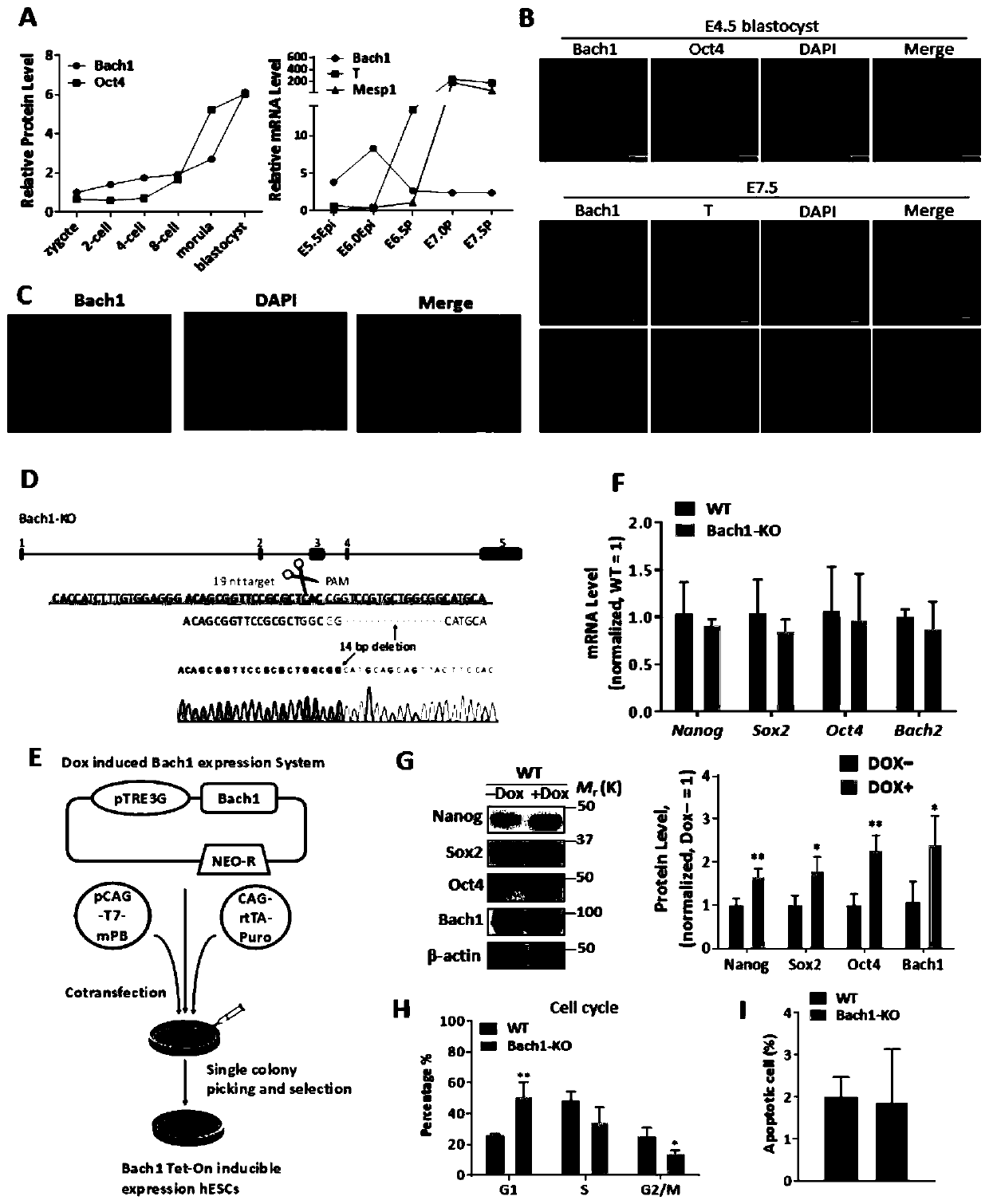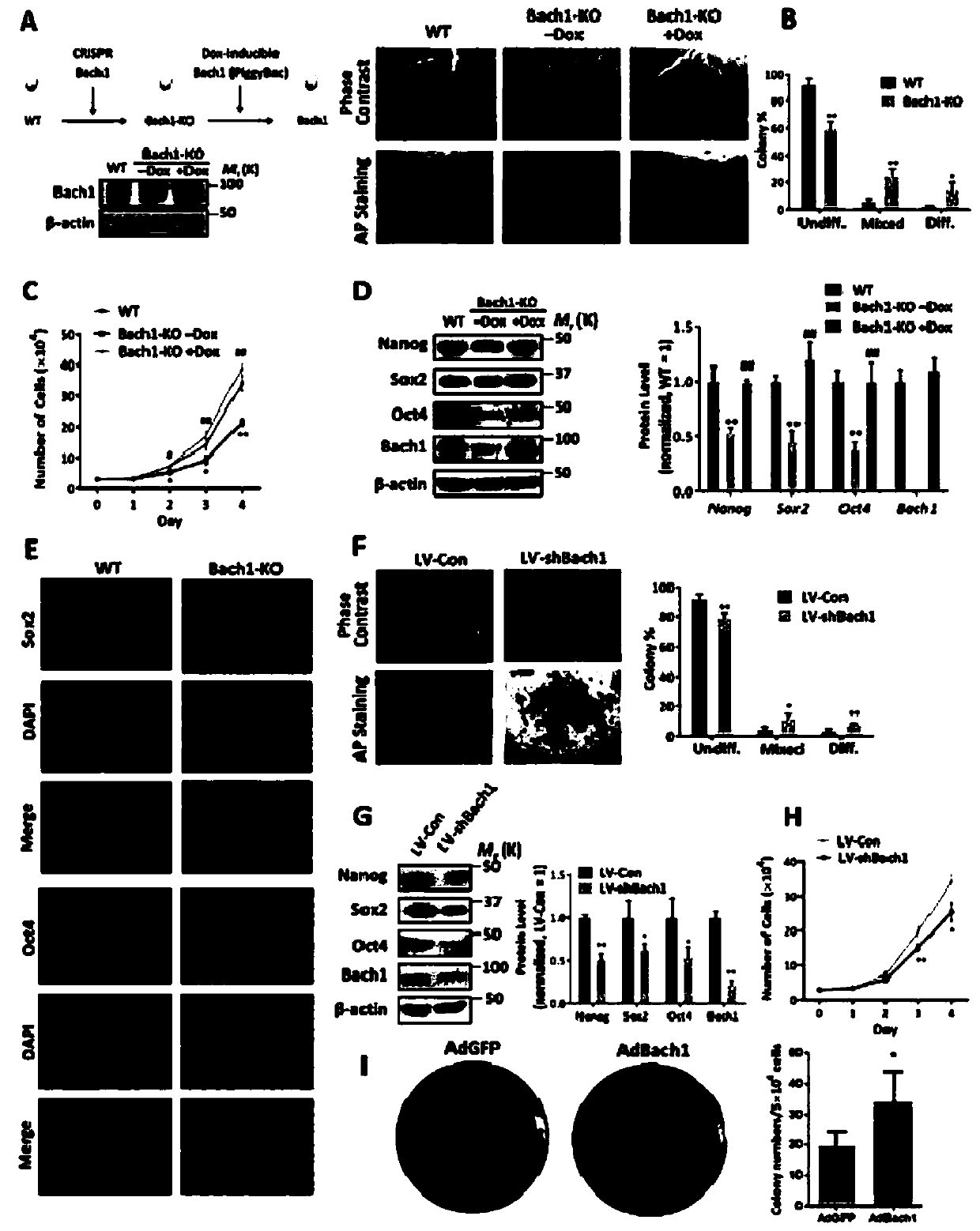A modified bach1 gene and its application
A gene and transcription factor technology, applied in the biological field, can solve the problems of growth factors and other substances that are not easy to obtain, complex components, and expensive, and achieve the effects of promoting development and clinical application, maintaining pluripotency, and inhibiting differentiation
- Summary
- Abstract
- Description
- Claims
- Application Information
AI Technical Summary
Problems solved by technology
Method used
Image
Examples
Embodiment 1
[0155] Example 1: Preparation of Bach1 knockout hESC
[0156] 1. Construction of sgRNA
[0157] Bach1-KO hESCs were generated by CRISPR / Cas9 gene editing technology. Use the CRISPR design tool to design sgRNA targeting the genomic region of interest (http: / / crispr.mit.edu / ), perform gene targeting for exon 2 of Bach1, conduct screening, and perform primer synthesis by Shanghai Sunny Company . sgRNA-1 target site sequence (SEQ ID NO: 1): 5'-GAC AGC GGT TCC GCG CTC AC-3' and its reverse complement sequence (SEQ ID NO: 2): 5'-GTG AGCGCG GAA CCG CTG TC-3'.
[0158] Its targeting strategy is as figure 1 D shows.
[0159] 2. Clone Guide RNA into the vector of Lenti crispr V2 (Addgene, Watertown, MA, #52961)
[0160] 2.1 Enzyme digestion and digestion of Lenti crispr V2 vector
[0161] Digest the Lenti crispr V2 vector according to the following system, 37°C, 2h
[0162] Table 1.1 20μl enzyme digestion system
[0163]
[0164] 2.2 Purify and recover the Lenti crispr V2 ve...
Embodiment 2
[0211] Example 2: Generation of Dox-inducible Bach1hESCs using the PiggyBac transposon system
[0212] 1. Construction of hBach1 overexpression plasmid to Piggy Bac transposon system
[0213] 1.1 Amplification of hBach1 target fragment
[0214] 1) Amplify the primers designed according to Table 2.1 to amplify the target fragment of hBach1, and KOD high-efficiency fidelity enzyme according to the PCR system in Table 2.2, and the amplification PCR program is shown in Table 2.3.
[0215] Table 2.1 Amplification Details
[0216]
[0217] Table 2.2 50μl PCR system
[0218]
[0219] Table 2.3 PCR amplification conditions
[0220]
[0221]
[0222] 2) Mix all the PCR products with 6×Loading Buffer, load all the samples, electrophoresis at 120V for 45min, cut out the target band from the agarose gel according to the size of the target band, and put it into a new 1.5ml EP tube weighing.
[0223] 3) Purify and recover the hBach1 target fragment according to the steps of...
Embodiment 3
[0239] Example 3: Bach1 maintains its stem cell properties in hESCs
[0240] Use Western Blot, alkaline phosphatase (AP) activity assay, lentivirus infection, RT-PCR, cell counting, flow cytometry, immunofluorescence method to measure cell growth, alkaline phosphatase (AP) activity, and pluripotency Protein levels of factors Sox2, Oct4 and / or Nanog.
[0241] The results showed that Bach1 was expressed in both inner cell mass (ICM) and trophectoderm cells, and suggested that Bach1 and Oct4 colocalized in the ICM cells of mouse blastocysts ( figure 1 B, above). Bach1 is also widely expressed in the endoderm, mesoderm and ectoderm of E7.5 embryos, while T is mainly expressed in the primitive streak region ( figure 1 B, the figure below).
[0242] Bach1 expression was observed in both the nucleus and cytoplasm of undifferentiated hESCs ( figure 1 C). Generation of Bach1 knockout hESCs (Bach1-KO hESCs) by CRISPR-Cas9 genome editing ( figure 1 D), and a schematic diagram of th...
PUM
 Login to View More
Login to View More Abstract
Description
Claims
Application Information
 Login to View More
Login to View More - R&D
- Intellectual Property
- Life Sciences
- Materials
- Tech Scout
- Unparalleled Data Quality
- Higher Quality Content
- 60% Fewer Hallucinations
Browse by: Latest US Patents, China's latest patents, Technical Efficacy Thesaurus, Application Domain, Technology Topic, Popular Technical Reports.
© 2025 PatSnap. All rights reserved.Legal|Privacy policy|Modern Slavery Act Transparency Statement|Sitemap|About US| Contact US: help@patsnap.com



